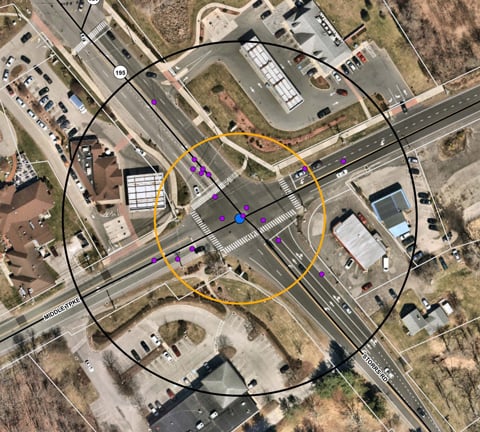
More than half the crashes in Connecticut’s Capitol Region from 2017 to 2019 occurred at intersections. Recognizing the urgent need for enhanced safety measures, the Capitol Region Council of Governments (CRCOG) initiated an ambitious study in 2021, collaborating with VHB. This study—unprecedented in New England and among only three in the nation at the time—aimed to upgrade intersection safety across the Greater Hartford Metro area. Covering 38 municipalities and approximately 43,000 intersections, the study’s scope was remarkable.
The Federal Highway Administration (FHWA) notes that modern single-lane roundabouts can reduce fatal and injury-causing crashes by up to 82 percent while maintaining efficient traffic flow. CRCOG enlisted VHB to pinpoint intersections where a single-lane roundabout could most enhance safety and operations. CRCOG required a data-informed analysis devoid of subjectivity, a task for which VHB was well-suited, given their established work in Connecticut alongside the University of Connecticut (UConn) and the Connecticut Department of Transportation (CTDOT).
Led by Joe Balskus, PE, PTOE, RSP1, a widely recognized authority on roundabouts and Chair of the 2024 Institute of Transportation Engineers (ITE) Roundabout Committee, the team devised a five-step methodology for managing the large volume of data. This included intersection location identification, crash review and screening, traffic volume screening, intersection geometry review, and desktop constructability reviews.
Automating the screening process saved significant fieldwork hours and established a method applicable to similar projects in the future. The team utilized an advanced geographic information system (GIS) application tool that integrated data from the CRCOG Regional Transportation Safety Plan (RTSP) and the Connecticut Roadway Safety Management System (CRSMS), both developed with VHB’s contribution.
After an initial screening of the CRCOG community's 43,000 intersections, the team refined the screening to roughly 8,000 potential roundabout candidates. Of these, more than 200 high-potential roundabout locations were desktop-reviewed. The final report, published last month by CRCOG, revealed:
- The top 100 potential roundabout locations
- The top three ranked locations in each CRCOG municipality
- Locations suggested by CRCOG municipalities
Thanks to this study, CRCOG can support the communities in making informed decisions on roundabout projects. The process and results could influence future intersection screening efforts nationwide.
“The ultimate goal is creating safer communities, a top priority for VHB’s transportation practice,” Joe Balskus shared. “As CRCOG moves forward supporting the Communities with roundabout conversions based on this study, VHB is ready to support these transformative projects from funding to design and implementation.”
To learn more about the Capitol Region Roundabout Screening Study and the many positive impacts of roundabout conversions, see the CRCOG website link, or connect with Joe via email or on LinkedIn.
